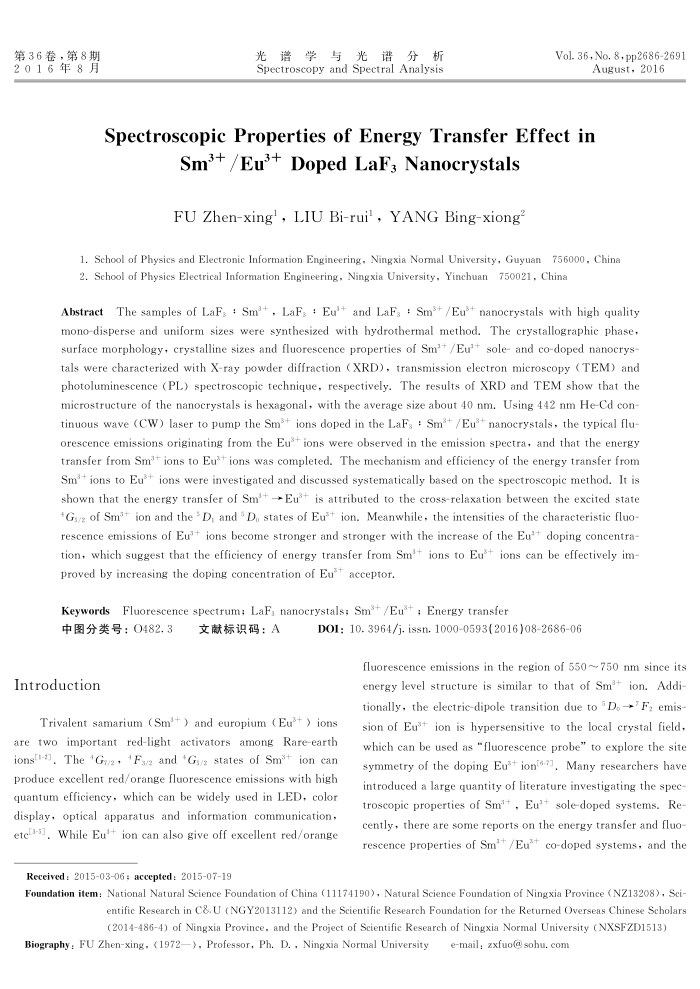LaF3纳米晶体中 Sm3﹢∕Eu3﹢能量传递效应的光谱学特性
内容简介
 第36卷,第8期 2016年8月
第36卷,第8期 2016年8月光谱学与光谱分析 Spectroscopy and Spectral Analysis
Vol.36,No.8+pp2686-2691
August,2016
SpectroscopicPropertiesofEnergyTransferEffectin
Sm3+ /Eu3+ Doped LaF3 Nanocrystals FU Zhen-xing',LIU Bi-rui',YANG Bing-xiong
1. School of Physics and Electronic Information Engineering, Ningxia Normal University, Guyuan 756000, China 2. School of Physics Electrical Information Engineering, Ningxia University, Yinchuan 750021, China
Abstracet The samples of LaF : Sm+, LaF : Eu+ and LaF : Sm+ /Eu+ nanocrystals with high quality monodisperse and uniform sizes were synthesized with hydrothermal method. The crystallographic phase, surface morphology, crystalline sizes and fluorescence properties of Sm'+ /Eu+ sole- and co-doped nanocrys-tals were characterized with X-ray powder diffraction (XRD), transmission electron microscopy (TEM) and photoluminescence (PL) spectroscopic technique, respectively. The results of XRD and TEM show that the microstructure of the nanocrystals is hexagonal, with the average size about 40 nm. Using 442 nm He-Cd con tinuous wave (CW) laser to pump the Sm+ ions doped in the LaF : Sm3+ /Eu3+ nanocrystals, the typical flu-orescence emissions originating from the Eu+ ions were observed in the emission spectra, and that the energy transfer from Sm+ ions to Eus+ ions was completed. The mechanism and efficiency of the energy transfer from Sm+ ions to Eus+ ions were investigated and discussed systematically based on the spectroscopic method. It is shown that the energy transfer of Sm+ +Eu°+ is attributed to the cross-relaxation between the excited state +Gs/2 of Sm+ ion and theD, and D, states of Eu+ ion. Meanwhile, the intensities of the characteristic fluo-rescence emissions of Eu+ ions become stronger and stronger with the increase of the Eu+ doping concentra-tion, which suggest that the efficiency of energy transfer from Sm+ ions to Eus+ ions can be effectively im-proved by increasing the doping concentration of Eu*+ acceptor.
KeywordsFluorescence spectrum; LaF, nanocrystals; Sm+/Eu+, Energy transfer
中图分类号:0482.3
Introduction
文献标识码:A
D0I: 10. 3964/j. issn. 10000593(2016)08268606
fluorescence emissions in the region of 550~750 nm since its energy level structure is similar to that of Sma+ ion. Addi-tionally, the electric-dipole transition due to D,→" F2 emis
Trivalent samarium (Sm*+) and europium (Eu+) ions are two important red-light activators among Rare-earth ions1-2. The 1Gr/2 , ^Fs/2 and *Gs/2 states of Sm+ ion can produce excellent red/orange fluorescence emissions with high quantum efficiency, which can be widely used in LED, color display, optical apparatus and information communication, ete[3-s]. While Eu'+ ion can also give off excellent red/orange
Received: 2015-03-06 ; accepted: 2015-0719
sion of Eus+ ion is hypersensitive to the local crystal field, which can be used as "fluorescence probe" to explore the site symmetry of the doping Eus+ ion6-. Many researchers have introduced a large quantity of literature investigating the spec troscopic properties of Sm+ , Eu+ sole-doped systems. Re cently+ there are some reports on the energy transfer and fluo-rescence properties of Sm'+ /Eu*+ co-doped systems, and the
Foundation item: National Natural Science Foundation of China (11174190), Natural Science Foundation of Ningxia Province (NZ13208), Sci-
entific Research in C&. U (NGY2013112) and the Scientific Research Foundation for the Returned Overseas Chinese Scholars(2014-486-4) of Ningxia Province, and the Project of Scientific Research of Ningxia Normal University (NXSFZD1513)
Biography : FU Zhen-xing, (1972—), Professor, Ph. D. , Ningxia Normal University
e-mail:zxfuo@sohu.com